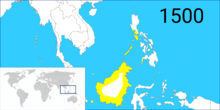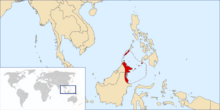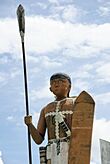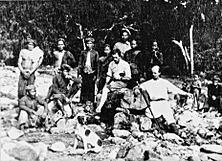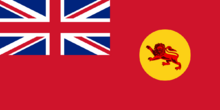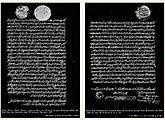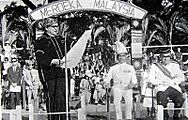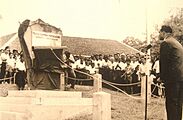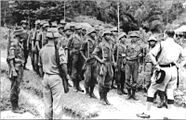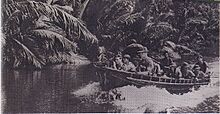History of Sabah facts for kids
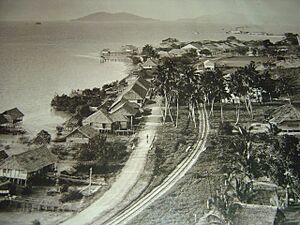
The history of Sabah goes back about 23,000 to 30,000 years. This is when the first people are thought to have lived in this area. Sabah's history is closely linked with the history of Brunei and the history of Malaysia. Sabah was once part of Brunei and is now part of Malaysia.
The first time Sabah was part of a big, organized society was in the early 1400s. This was during the powerful time of the Sultanate of Brunei. Before this, people in Sabah mostly lived in tribal groups. Some tribal groups continued to exist even into the 1900s.
In 1658, the Sultan of Brunei gave the eastern part of Sabah to the Sultan of Sulu. This was a thank you for helping Brunei win against its enemies. However, some sources say this land was never truly given away. By the late 1800s, British groups gained control of lands from both the Brunei and Sulu Sultans. This led to the creation of British North Borneo, managed by the North Borneo Chartered Company.
Sabah became a protectorate of the United Kingdom in 1888. Later, from 1946 to 1963, it was a Crown colony known as the Crown Colony of North Borneo. On September 16, 1963, Sabah joined with Malaya, Sarawak, and Singapore (which left in 1965) to form Malaysia.
Contents
Early History of Sabah
About 20,000 years ago, during the Last Glacial Maximum (a very cold period), Sabah and the rest of Borneo island were connected to mainland Asia. This large landmass was called Sundaland. When the ice melted, sea levels rose, and Sundaland was covered by water. This separated Borneo from Asia.
The first people are thought to have lived in Sabah about 20,000 to 30,000 years ago. These early humans might have been Australoid or Negrito people. We don't know why they disappeared. Stone tools and other old items have been found in Madai and Baturong caves. An archaeological site near Lake Tingkayu in Kunak also has tools from 28,000 to 17,000 years ago. These tools were quite advanced for their time.
There is also proof of people living in caves from 15,000 to 6,000 years ago. Recent studies in 2012 found even older stone tools in Mansuli Valley near Lahad Datu. These tools are believed to be 235,000 years old. Another site in Kampung Lipasu, Bingkor, has tools at least 200,000 years old. These findings suggest that people lived in Sabah much earlier than previously thought.
The next big group of people, believed to be Austronesians, arrived about 5,000 years ago. These people are thought to be the ancestors of today's native hill people in Sabah. This includes the Murut, Lundayeh, Kadazan-Dusun, and Orang Sungai groups. Brunei Malay settlements appeared a bit later.
Some early Australoid or Negrito people might have mixed with the later Austronesian migrants and stayed in Borneo. Others may have moved to places like Melanesia, the Lesser Sunda Islands, and Australia.
Before the 1400s
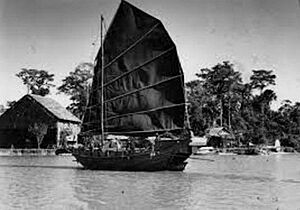
In the 600s CE, a community called Vijayapura existed on the northeast coast of Borneo. It was part of the Srivijaya empire and was thought to be linked to the early Bruneian Empire. This community was founded by a prince from Funan among the early coastal Dusun people.
Chinese records from the 800s mention another kingdom called P'o-ni. This kingdom was also founded by ancient Dusun people. It is believed that Po-ni was located at the mouth of the Brunei River and was the start of the Sultanate of Brunei.
In 1410, the Brunei Annals mentioned a Chinese settlement in the Kinabatangan Valley on the east coast. This settlement was founded by a man named Ong Sum Ping. This matches recent discoveries of wooden coffins in the Agop Batu Tulug cave in the Kinabatangan Valley. These coffins belong to the Dusun Sukang tribe. The carvings on the coffins look like cultural practices in China and Vietnam. They are thought to be from 700 to 1,000 years ago (1000s to 1300s). From the 1300s, the Majapahit empire started to influence Brunei and most of Borneo's coastal areas.
Brunei and Sulu Sultanates
The Sultanate of Brunei began after its ruler became a Muslim. This happened around 1365 CE when Awang Alak Betatar converted to Islam and became known as Muhammad Shah. Other sources suggest this conversion happened later, around 1514 to 1521 CE, but still under the same person.
During this time, trade grew, and marriages between native Borneo people and Chinese and Arab traders became common. This mixing of cultures created unique physical features in the people. The Sultanate of Brunei grew very powerful during the rule of its fifth sultan, Bolkiah, from 1485 to 1524. His kingdom, which controlled the seas, stretched over Sabah, the Sulu Archipelago, and Manila in the north. It also reached Sarawak and Banjarmasin in the south. This was the "golden era" of the Sultanate.
In 1658, the Sultan of Brunei gave the northern and eastern parts of Borneo to the Sultanate of Sulu. This was a payment for Sulu's help in ending the Brunei Civil War. The Sultan of Brunei continued to loosely rule the west coast of Sabah. Many Brunei Malays moved to this area during this time, a migration that had started as early as the 1400s.
While the Brunei and Sulu sultanates controlled the western and eastern coasts of Sabah, the inland areas remained mostly independent. From the late 1700s, the seafaring Bajau and Suluk people also arrived from the Sulu Archipelago. They started settling on the coasts of northern and eastern Borneo. It is believed they were escaping harsh rule from the Spanish colonies in their home region.
-
The size of the Bruneian Empire in the 1400s, under Sultan Bolkiah.
-
The size of the Sultanate of Sulu in 1822.
British North Borneo
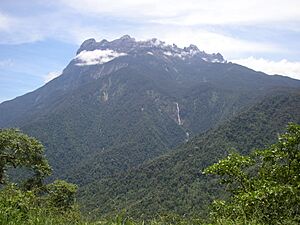
In 1761, Alexander Dalrymple, an officer from the British East India Company, made a deal with the Sultan of Sulu. This allowed him to set up a trading post in the region. However, this plan and other attempts to build settlements on Balambangan Island failed. A map of North Borneo made by Dalrymple is now in the National Museum of Scotland. After this, there was little foreign interest in the region. Control over most of northern Borneo remained loosely under the Sultanate of Brunei.
In 1846, the island of Labuan on Sabah's west coast was given to Britain by the Sultan of Brunei. In 1848, it became a British Crown Colony. Labuan became a base for the British to fight pirates in the area. The first recorded climb of Mount Kinabalu, Borneo's highest mountain, was in 1851. It was done by Hugh Low, a British colonial administrator and naturalist. The highest peak and a deep valley on the mountain were later named after him.
In 1865, Charles Lee Moses, the American Consul General in Brunei, leased North Borneo for 10 years from Sultan Abdul Momin of Brunei. The rights then went to the American Trading Company of Borneo. This company was owned by Joseph William Torrey, Thomas Bradley Harris, and some Chinese merchants. They set up a base in Kimanis, and the Sultan of Brunei named Torrey "The Rajah of Ambong and Marudu." Torrey returned to America in 1877 and died in 1884.
The trading company's rights were then sold to Gustav Baron Von Overbeck. He was the Austro-Hungarian Consul in Hong Kong, but he was German. He got another 10-year lease renewal. This lease was later changed into a full transfer of land through a treaty signed by Sultan Abdul Momin. In this treaty, the Sultan named Overbeck "Maharajah of Sabah and Rajah of Gaya and Sandakan." This treaty gave Overbeck rights over all of Sabah, including parts that were supposedly under the Sulu Sultanate, like Sandakan and Tawau. The treaty was signed on December 29, 1877, at the Brunei Palace. In 1880, Overbeck tried to offer the territory to the Kingdom of Italy as a place for prisoners. But with British pressure, Italy refused, and Britain soon took over the region. Similar offers were also made to Austria-Hungary and the German Empire.
On the east coast of North Borneo near Sandakan, William Cowie, working for Dent's company, got a permanent concession from the Sultan of Sulu in 1878. This was for the Sultan's lands in that region. This concession was signed on January 22, 1878, at the Sultan of Sulu's palace. This concession later became a point of disagreement with the modern country of the Philippines, regarding its historical link to eastern Sabah.
The rights were then given to Alfred Dent. On August 26, 1881, he formed the British North Borneo Provisional Association Ltd. On November 1, 1881, the British government gave them a royal charter, and the British North Borneo Chartered Company was formed. William Hood Treacher became the first British Governor of North Borneo, with Kudat as the first capital.
Since there weren't enough people to fully develop the region's economy, the company brought in Chinese people, mostly Hakkas from Guangdong province. They came to work as laborers on farms. Most of these migrants settled in Kudat and Jesselton (now Kota Kinabalu). The capital was moved to Sandakan in 1884 to make use of its large timber resources. In 1885, the United Kingdom, Spain, and Germany signed the Madrid Protocol of 1885. This agreement recognized Spain's control over the Sulu Archipelago and made Spain give up any claims it had over North Borneo.
In 1888, North Borneo became a protectorate of the United Kingdom. The Company still managed and controlled North Borneo, even as a protectorate. They ruled effectively until 1942. Their rule was mostly peaceful, except for some rebellions. One was led by the Bajau-Suluk leader Mat Salleh from 1894 to 1900. Another was led by Antanum of the Muruts, known as the Rundum resistance in 1915. Many Suluk people moved to North Borneo during this time because of the Spanish invasion of the Sulu Archipelago.
Starting in 1920, more Chinese migrants arrived from Guangdong, Fujian, and even Hebei provinces. This happened after the British changed their immigration rules to boost the economy. There was also Javanese migration to North Borneo starting in 1891. The British later recruited more laborers from Java from 1907 onwards. Other important migrants from present-day Indonesia included the Bugis people from the 1890s. Florenese people and Timorese from Flores and West and East Timor arrived in the early 1950s.
The first Native's Paramount Leader was Pehin Orang Kaya-Kaya Koroh Santulan. He was from Ansip & Kadalakan, also known as old Keningau town. He was the father of former Sabah State Minister Tan Sri Stephen (Suffian) Koroh and Sabah's fifth State Governor Tun Thomas (Ahmad) Koroh. Santulan, who was also a Pengeran, was a Murut descendant of Omar Ali Saifuddin I, the 18th Sultan of Brunei.
-
Map of North Borneo from the British Library, 1888.
-
Joseph William Torrey was given permission by the Sultanate of Brunei to operate in the entire northern part of Borneo. This included areas from Sulaman on the west to the Pietan river on the East, and the states of Paitan, Sugot, Banggayan, Labuk, Sandakan, China Bantangan, Gagayan Mumiang, Benuni and Kimanis. It also included the islands of Banguey, Palawan and Balabao on November 24, 1865.
-
Left: The first agreement was signed by Sultan Abdul Momin of Brunei. It appointed Baron de Overbeck as the Maharaja of Sabah, Rajah of Gaya, and Sandakan. This was signed on December 29, 1877.
Right: The second agreement was signed by Sultan Jamal ul-Azam of Sulu. It also appointed Baron de Overbeck as Dato Bendahara and Raja of Sandakan on January 22, 1878, about three weeks after the first agreement.
Japanese Occupation and Allied Liberation
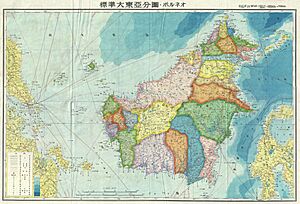
During World War II, Japanese forces landed in Labuan on January 3, 1942. They then invaded the rest of North Borneo. From 1942 to 1945, the Japanese army occupied North Borneo, along with most of the island. Bombings by the Allied forces destroyed most towns, including Sandakan, which was completely ruined.
Resistance against the Japanese occupation was strong on the west and north coasts of North Borneo. In Jesselton, the resistance was led by Albert Kwok and Jules Stephens of the Kinabalu Guerillas. Another resistance group was led by Panglima Alli from Sulug Island, near Jesselton. In Kudat, Mustapha Harun also led some resistance.
On October 10, 1943, the Kinabalu Guerrillas and Panglima Alli's followers launched a surprise attack on the Japanese. However, the attack failed. The 324 local people who took part, including Albert Kwok and Panglima Alli, were captured in Petagas. They were later executed on January 21, 1944. The place of their execution is now known as the Petagas War Memorial.
In Keningau during World War II, Korom was a rebel. Some say he was a Sergeant with the North Borneo Armed Constabulary. It is claimed that he spied for the Allied Forces by pretending to work for the Japanese. He gave information about Japanese positions. Some people credit him with helping 500 Allied prisoners of war (POWs) escape. Fighting alongside Korom were Garukon, Lumanib, Kingan, Mikat, Pensyl, Gampak, Abdullah Hashim, Ariff Salleh, Langkab, Polos, Nuing, Ambutit, Lakai, Badau, and many Chinese fighters.
In Sandakan, there was a very harsh POW camp run by the Japanese for British and Australian POWs. The prisoners suffered terribly in their first year. But much worse was to come during the forced marches in January, March, and June 1945. Allied bombings made the Japanese move the POW camp inland to Ranau, 260 km away. All 2,504 prisoners were forced to march in what became known as the infamous Sandakan Death March. Sickness, disease, exhaustion, thirst, hunger, beatings, and shootings killed most of the prisoners. Only six Australians managed to escape, were not caught, and survived to tell the horrific story. The people who died on this march are remembered every year on Anzac Day in Australia and in Sandakan. There is a museum and a memorial monument at the original POW campsite.
The war ended when Lieutenant-General Baba Masao of the 37th Japanese Army officially surrendered in Labuan on September 10, 1945. After the surrender, North Borneo was managed by the British Military Administration. In 1946, it became a British Crown Colony.
Until the Philippines gained independence in 1946, seven British-controlled islands near the northern coast of Borneo were given to the Philippine government. These were the Turtle Islands (including Cagayan de Tawi-Tawi and Mangsee Islands). Because Sandakan was so badly destroyed in the war, Jesselton was chosen as the new capital. The British Crown continued to rule North Borneo until 1963.
-
Japanese civilians and soldiers leaving North Borneo after Japan surrendered to the Australian forces.
Self-Government and the Formation of Malaysia
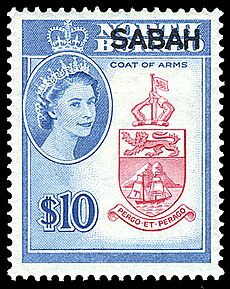
On August 31, 1963, North Borneo gained self-government. The idea of forming a union of former British colonies (Malaya, Singapore, Sarawak, and North Borneo) was discussed as early as the late 1800s. But it was Tunku Abdul Rahman who officially suggested this larger federation in May 1961. The British also seemed to support this idea. There was a call for full independence on that date, but the British Governor, who was still in power, denied it until Malaysia Day.
In 1962, the Cobbold Commission was set up. Its job was to find out if the people of Sabah and Sarawak wanted to join the proposed union. The commission found that most people supported the union. However, they wanted certain conditions to protect their interests. The commission also noted some opposition but decided it was minor. The commission published its report on August 1, 1962, with several recommendations. Unlike in Singapore, no referendum (public vote) was held in Sabah.
Most ethnic community leaders in Sabah eventually supported the formation. This included Mustapha for the Muslims, Donald Stephens for the non-Muslim natives, and Khoo Siak Chew for the Chinese. An agreement to form the union was signed on August 1, 1962. It was signed by Tunku Abdul Rahman, Harold Macmillan (the British Prime Minister), and William Goode (the last Governor of North Borneo).
The plan was to form Malaysia on August 31, 1963. But because of objections from the Philippines and Indonesia, the formation was delayed until September 16, 1963. On that day, North Borneo, now called Sabah, united with Malaya, Sarawak, and Singapore to form Malaysia. To protect Sabah's interests in the new federation, a 20-point agreement was made between the federal and state governments.
-
Donald Stephens (left) announcing the formation of Malaysia at Padang Merdeka, Jesselton on September 16, 1963. With him are the Deputy Minister of Malaya Tun Abdul Razak (right) and Mustapha Harun (second right).
Indonesian Confrontation and Brunei Revolt
Before and during the formation of Malaysia until 1966, Indonesia had a hostile policy towards Malaya and then Malaysia. This undeclared war was supported by British forces. Indonesian President Sukarno saw Malaysia as an expansion of British influence. He wanted to control all of Borneo under Indonesia.
Around the same time, some groups, especially the Brunei People's Party, suggested forming a North Borneo Federation. This would include Sabah, Sarawak, and Brunei. This idea led to rebel attacks in Brunei and parts of Sabah and Sarawak. The Bruneian Army, with help from the British, stopped the rebellion in December 1962.
-
Royal Marines Commando unit patrolling a river in Serudong, Sabah. They were guarding the state during the Indonesia–Malaysia confrontation.
Philippine Claim to Eastern Sabah
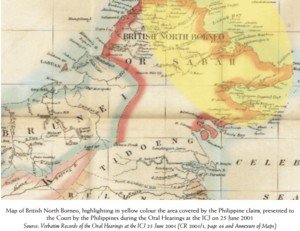
The Philippines still claims eastern Sabah (formerly North Borneo). This claim is based on an agreement signed in 1878 between the Sultan of Sulu and the North Borneo Chartered Company. The Philippines believes that the Sultanate's control over the land was not ended. They say North Borneo was only leased to the North Borneo Chartered Company.
However, Malaysia considers this claim a "non-issue." Malaysia believes the 1878 agreement was a full transfer of land. Malaysia also believes that the people of Sabah used their right to self-determination (decide their own future) when they joined the Malaysian federation in 1963.
After Independence
-
The official flag of the state of Sabah (1988–present).
Tun Fuad Stephens became Sabah's first chief minister. The first Governor (Yang di-Pertuan Negeri) was Mustapha Harun. Sabah held its first state election in 1967. On June 6, 1976, Tun Fuad Stephens and other state ministers died in a plane crash. This event is known as the Double Six Tragedy. He had only been elected for his second term as chief minister 44 days earlier. Harris Salleh replaced him.
On June 14, 1976, the Sabah government signed an agreement with Petronas. This is the federal government's oil and gas company. The agreement gave Petronas the right to take oil from Sabah's waters. In return, Sabah would get 5% of the annual revenue as royalties. Under Harris Salleh's leadership, the Sabah state government gave the island of Labuan and its 6 smaller islands to the Malaysian federal government. Labuan was declared a federal territory on April 16, 1984.
In 1985, after the state elections, Pairin Kitingan of Parti Bersatu Sabah (PBS) became the seventh chief minister. This was only the second time in Malaysia that a party not linked to the national ruling coalition formed the government in any state. In the same year, armed groups attacked Lahad Datu. They killed 21 people and injured 11 others in an event known as the 1985 Lahad Datu ambush. In 1986, opponents of the newly elected PBS government started riots around the state. These were mainly in Kota Kinabalu, Tawau, and Sandakan. The riots caused bombings and five deaths. Peace slowly returned after a snap election in 1986. This election strengthened PBS's position as the ruling state government.
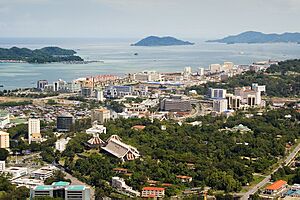
From 1990 to 1991, several PBS politicians were arrested. They were held under the Internal Security Act. They were accused of planning for Sabah to leave the Malaysian Federation. Among those arrested were Jeffrey Kitingan and Maximus Ongkili. Other politicians, including Pairin, faced corruption charges. These arrests and charges were thought to be politically motivated.
After the 1994 state election, Barisan Nasional regained control of the state. This happened through the creation of the Sabah branch of the United Malays National Organisation (UMNO) party and other parties. The rotation system was introduced by the then prime minister Mahathir Mohamad. Under this system, the chief minister post would rotate every two years among Sabah's three main communities. These were the Muslim Bumiputeras, non-Muslim Bumiputeras, and the Chinese. Sakaran Dandai became the first chief minister under this system in 1994. The rotation system was finally stopped in 2005, with Musa Aman as the current chief minister. On December 26, 1996, Sabah was hit by one of the worst tropical storms, Tropical Storm Greg. The storm hit the western coast, causing over 200 deaths and destroying thousands of homes.
In 2000, the state capital Kota Kinabalu was given city status. This made it the 6th city in Malaysia and the first city in Sabah. Also in 2000, Kinabalu National Park was officially named a World Heritage Site by UNESCO. It was the first site in Malaysia to get this special recognition. On May 3, the Abu Sayyaf armed group from the southern Philippines arrived on the resort island of Sipadan. They kidnapped 21 people, including tourists and resort workers, for money. Most hostages were rescued on September 16, 2000, after an attack by the Philippine army. In 2002, the International Court of Justice ruled that the islands of Ligitan and Sipadan, which Indonesia also claimed, are part of Sabah and Malaysia.
In early 2013, an armed group calling themselves the "Royal Sulu Army" entered Sabah. They wanted to reclaim the eastern areas as part of the Sultanate of Sulu. This led to a standoff and then a conflict between the group and Malaysian security forces. It ended with the deaths of 56 armed group members, 10 Malaysian security personnel, and 6 civilians. Soon after, Sabah became a target for criminals and armed groups from the southern Philippines, like Abu Sayyaf and followers of the Moro National Liberation Front under Nur Misuari. So far, Sabah has held 12 state elections. It has had 14 different chief ministers and 10 different Yang di-Pertua Negeris (Governors).
The Malaysia-Sulu Case
In 2019, the Sabah region gained global attention because of the Malaysia-Sulu Case. This case involved a very large claim for money made by people who said they were descendants of the last Sultan of Sulu Empire. They made this claim against the Malaysian government.
The claim was about the region of Sabah and an old agreement from the colonial era. The 1878 agreement was a deal with the Sulu Sultan for the use of his territory, which is now in present-day Malaysia. The Malaysian government continued to honor this agreement until 2013. After that, they stopped making payments, which led to this legal case.
The people making the claim asked for US$32 billion. In January 2022, a Spanish arbitrator (a person who helps settle disputes) named Gonzalo Stampa ruled in favor of the claimants. He awarded them US$15 billion. This was the largest such award in international legal history. However, this award was later canceled by the Hague Court of Appeal on June 27, 2023.



